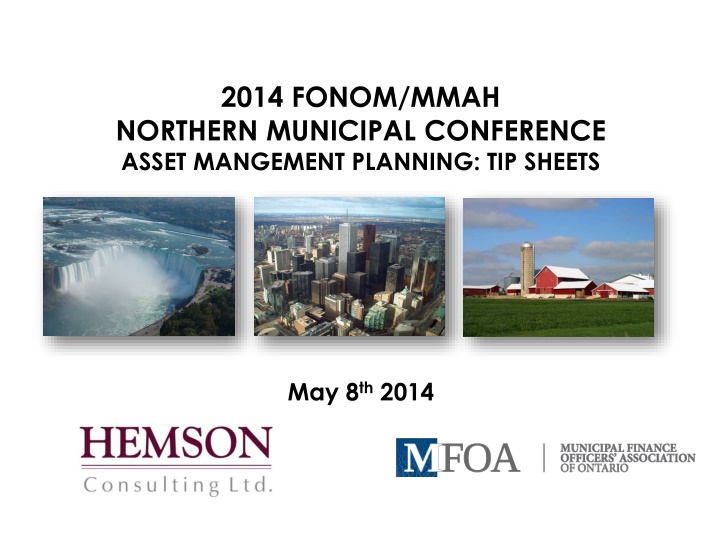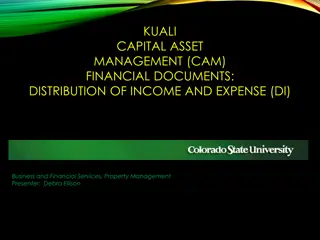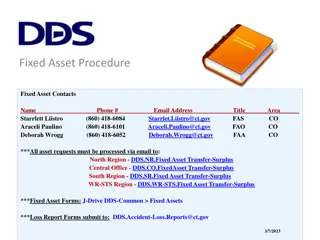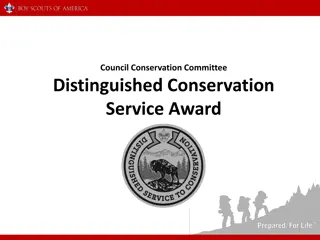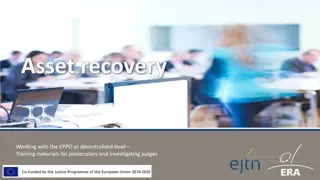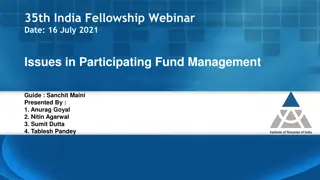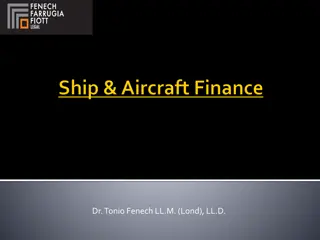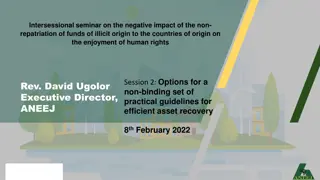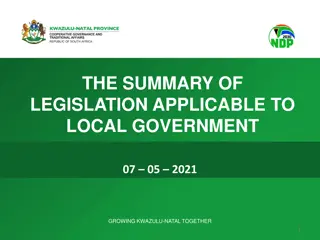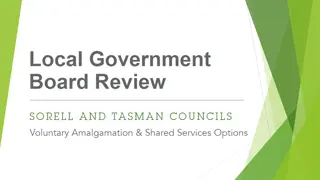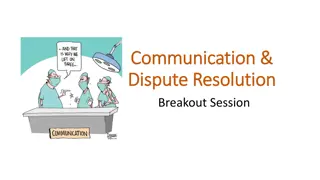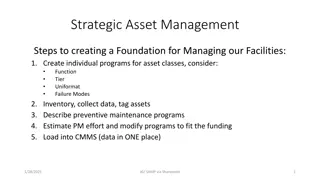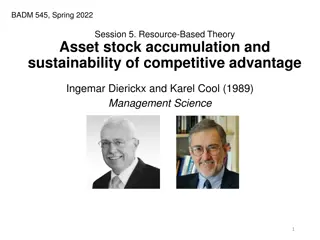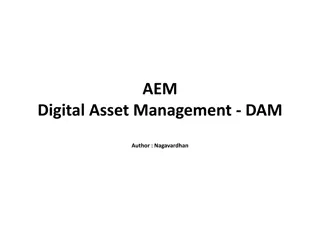Asset Management Planning Tips for Municipal Councils
This document provides valuable tips on reporting to council, key information to present, samples of information presentations, and insights on infrastructure deficit for effective asset management planning in municipalities.
Download Presentation

Please find below an Image/Link to download the presentation.
The content on the website is provided AS IS for your information and personal use only. It may not be sold, licensed, or shared on other websites without obtaining consent from the author.If you encounter any issues during the download, it is possible that the publisher has removed the file from their server.
You are allowed to download the files provided on this website for personal or commercial use, subject to the condition that they are used lawfully. All files are the property of their respective owners.
The content on the website is provided AS IS for your information and personal use only. It may not be sold, licensed, or shared on other websites without obtaining consent from the author.
E N D
Presentation Transcript
2014 FONOM/MMAH NORTHERN MUNICIPAL CONFERENCE ASSET MANGEMENT PLANNING: TIP SHEETS May 8th 2014
Topics Introduction & Overview MFOA work with MMAH Hemson s Involvement Asset Management Tip Sheets 1. Reporting to Council on Asset Management Plans 2. Meeting Requirements of O.Reg. 284/09 3. Integrated Asset Management Planning 4. Budgeting for Long Term Asset Management 5. Council Decision Making: Evidence Based 6. Asset Management Planning & Implementation Q&A 1
Tip Sheet #1 Reporting to Council Tasked with keeping Council & the Public informed Getting Council buy in to fund capital infrastructural renewal is a challenge A key to success: Providing Council with the right information to make informed decisions 2
Tip Sheet #1 Key Information to Provide 1. Condition of assets and asset categories 2. Remaining Useful life of assets 3. Total replacement value of assets? 4. Consequence of asset failure 5. Recommendation of building reserves 3
Tip Sheet #1 Sample of Information Presentation Age of Tax Supported Infrastructure by Remaining Useful Life 50% Important for to illustrate the remaining useful life of assets in conjunction with the condition assessment analysis $100,000,000 $50,000,000 15% 12% 9% 6% 5% 3% $- Asset Condition Assessments Good (235.5M) Fair ($113.2M) Poor ($15.2M) Water Old infrastructure does not necessarily mean the assets are in poor condition Wastewater Bridges & Culverts Roads and Related 0% 20% 40% 60% 80% 100% 4
Tip Sheet #1 Infrastructure Deficit Infrastructure Deficit will Continue to Increase Under Exisiting Conditions Infrastructure Deficit "Overdue" Assets Required Immediately Infrastructure Deficit In-Year Capital Contributions Buildings Sidewalks Fleet Bridges Roads Wastewater Water In-Year Capital Requirements $45,000,000 $25,000,000 $40,000,000 $35,000,000 $20,000,000 $30,000,000 $25,000,000 $15,000,000 $20,000,000 $15,000,000 $10,000,000 $10,000,000 $5,000,000 $5,000,000 $0 $0 -$5,000,000 2013 2015 2017 2019 2021 2023 2025 2027 2029 2031 2013 2015 2017 2019 2021 2023 2025 2027 2029 2031 How much infrastructure is overdue? Is the deficit improving or worsening? 5
Tip Sheet #1 Annual Provisions How much should we be contributing annually? What are we doing currently? 6
Tip Sheet #1 Effective Communication of Results Easy to interpret charts will help Council and Public understand the state of municipal infrastructure and how it is changing. How have the Condition of our Assets Changed? 2016 57% 28% 15% Good 2015 56% 27% 17% Fair 2014 56% 26% 18% Poor 2013 55% 25% 20% 0% 20% 40% 60% 80% 100% Illustrating year-over- year changes in reserves can help Council understand significant contributions or withdrawals (related to capital investment) Annual Change in Reserve Funds Water Wastewater Tax Supported $4,000,000 $3,000,000 $2,000,000 $1,000,000 $- 2008 2009 2010 2011 2012 2013 2014 2015 2016 2017 7
Tip Sheet #2 Requirements of O.Reg 284/09 Under the Municipal Act: Municipalities are required to prepare annual statements on a full accrual basis Recording of assets amortized over their useful life not as a expenditure in year acquired Appear on Statement of Operations Required to prepare balanced budgets Would have profound budgetary implications for Ontario Municipalities O.Reg 284/09 introduced 8
Tip Sheet #2 Requirements of O.Reg 284/09 The regulations allows municipalities to exclude amortized costs and other costs If followed, municipalities must produce an annual report: Estimate of the change in accumulated surplus resulting from excluded expenses Analysis of the estimate impact of the exclusions A full response and review to Regulation 284/09 was undertaken by MFOA. The document pertaining to this review can be located through the link below: http://www.mfoa.on.ca/sites/default/files/MFOA_response_to_review_of_284_09.pdf 9
Tip Sheet #2 Impact on Ending Accumulated Surplus Notes: Outline for Conversion from Fund to Accrual Accounting Budgeted Surplus: $0.00 Legislated to be $0 1. Capital Assets Less: Amortization Expense Previous years amortization expense Less: Amortization related to disposals Add: Amortization of acquired assets Add: Budgeted Tangible Capital Asset Acquisition Capital program less non-TCA expenditures Less: Proceeds of Denbentures Add: Debt Principal Payments Under the accrual method, debt principal payments are considered a reduction of the liability and not an expense 2. Post-Employment Benefits Under full accrual accounting, any amounts expected to be paid on behalf of employees on or after retirement will be expenses throughout the employee's active service life. Post-Employment benefits include the following: Continuation of health benefits after retirement WSIB partial disability pensions to former employees payout of frozen sick leave credits on retirement Less: Change in Unfunded Post Employment Benefits Liability Increase in Post-Employment Benefits Liability less any contributions to related reserves 3. Post-Closure Landfill Expenses Less: Change in Unfunded Landfill Closure and Post Closure Liability The reporting of landfill closure and post closure expenses reduces the accumulated surplus. Estimated Impact on the Ending Accumulated Surplus 10
Tip Sheet #2 Weakness of Using Amortization Assets that are fully depreciated will not be included Depreciation funds historical costs and not replacement costs which will be greater Would not consider non- tangible capital assets 11
Tip Sheet #2 Example: Amortization vs. Full Cost Saving Saving for the Replacement of an Asset is different than Funding Annual Amortization Replacement Amortization $1,600,000 $1,400,000 $1,200,000 $1,000,000 $800,000 $600,000 $400,000 $200,000 $- 1 2 3 4 5 6 7 8 9 10 Assumptions: 2014 Cost: $1,000,000 Useful Life: 10 Years (replacement in 2024) Replacement cost: $1.4 million Result if Amortization used : A funding shortfall in excess of $400,000 12
Tip Sheet #2 Estimating the Impact of Exclusions Document existing capital funding levels actual capital-related activity provisions to reserves for asset replacement Identify how much you should be investing in to tangible capital assets each year 13
Tip Sheet #3 Asset Management & Strategic Planning DEVELOPMENT CHARGES STUDY LONG-RANGE FINANCIAL PLAN ASSET MANAGEMENT STUDY WATER & SEWER FULL COST RECOVERY STUDIES GROWTH MANAGEMENT STUDY ROADS MANAGEMENT STUDY/SOFTWARE PERFORMANCE MEASUREMENT FLEET MANAGEMENT PROGRAM/SOFTWARE SERVICE LEVEL TRACKING & ANALYSIS INSURANCE SCHEDULES FINANCIAL DOCUMENTS OTHER OTHER (Grant Applications) 14
Tip Sheet #3 Long Range Financial Planning Context Base Parameters (Forecasts, Plans, Policies) Population, Housing, Demographic & Non-Residential Projections Financial Parameters, Assumptions & Drivers Assessment, Tax & Rate Revenue Forecasts Infrastructure Repair & Replacement Operating & Capital Forecast Tax and Rate Impact Analysis Financial Policies, Objectives & Measures Sensitivity Testing 15
Tip Sheet #3 Capital Budgeting 101 Not everything can be done at once Establish short, medium and long- term goals Being prepared is very important Municipalities should: Regularly update their asset registry Improve information for full range of capital assets in addition to engineering related infrastructure improve and update condition assessments and replacement costs 16
Tip Sheet #3 Developing a Capital Prioritization Model Develop a Capital Prioritization Model to evaluate the validity of each project Weigh the importance of each project based on some general guideline: Health and Safety Service Levels Strategic directions and community priorities Mandates Operating budget implications Economic Development 17
Tip Sheet #3 Important Considerations Assets that possess environmental or health risks should be considered highest priority Think about desired service levels e.g. allow more cracks on a road before replacement e.g. change standards for contributed capital to better acknowledge municipality's requirement to replace it Consider Council goals and objectives Factor in operating budget implications 18
Tip Sheet #3 Funding of Prioritized Projects Key funding questions you should answer after your projects have been identified 1. Can the projects be funded under existing conditions? 2. Would their be significant increase to user rates or property taxes ? Identify level of increase required Can alternative revenue tools be used 3. Can debt financing be used? 19
Tip Sheet #4 Budgeting & Revenue Sources Finding revenue for funding asset management needs and reserve contributions is often a challenge http://www.unclaimedmoney.com/news/wp-content/uploads/2012/06/unclaimed-money-search.jpg Property taxes and utility rates are the key revenue sources but there are other revenues tools A comprehensive wide- ranging asset management funding is the best approach 20
Tip Sheet #4 Overview of Revenue Tools Revenue Tool Description Benefits Considerations Expense Dedicated Infrastructure Levy dedicated % of tax levy to fund infrastructure stable and predictable high degree of control can be opposition as seen as tax increase Dedicated taxes can be easier to get implemented often used as transfer to asset management reserve fund can fund non- DC fundable growth costs User Fees true full cost recovery utility rates all surcharge on other rates applies the benefit- received principle often easier to get approved can be issues of equitability (impact on lower income households) double taxation? beneficial to make specific transfer to asset management reserve fund 21
Tip Sheet #4 Overview of Revenue Tools Revenue Tool Local Improvement Charges Description can be used to fund capital costs of localized capital improvements Benefits legislative basis long historic practice easy to implement direct linking with benefitting land owners Considerations some don t consider for replacement of assets easier if involves improvement Not applicable for large projects Expense often used for funding of linear infrastructure roads (incl. street lighting), sidewalks, sewers, watermains, etc Development Charges tool to fund initial round of development related capital requires linkage to increase in demand/needs arising from development limited application to asset replacement unless existing asset being upgraded (ie. Large size) fund growth- related expenditures don t fund 100% of all costs renewal expenses not typically fundable from DCs 22
Tip Sheet #4 Overview of Revenue Tools Revenue Tool Description Benefits Considerations Expense Developer Contributions municipalities obtain a wide- range of assets through developer contributions usually through agreement share service agreements can be used to respond to local community challenges can reduce tax and rate impacts in certain circumstances can be used for asset replacement usually linked to development applications Not guaranteed potential challenges at the OMB and/or courts can be difficult to implement municipality does not have total control focus is on new infrastructure and limited application to asset management and replacement Can be used for a wide- range of municipal services and assets fleet, fire services, airport services, animal control, etc Shared Services costs, including asset management costs, can be shared between several parties increase ability to manage service and service levels 23
Tip Sheet #4 Overview of Revenue Tools Revenue Tool Description Benefits Considerations Expense Public Private Partnerships (P3 s) common tool for delivering large infrastructure projects funding costs can include full asset life-cycle Debt is a financing tool rather than a source of funding risk are shared between public and private sector Can result in lower capital and operating costs can be used to spread the cost of the asset over the useful life and over the benefitting population less control of project/asset Increased legal and administrative costs usually only applicable to large scale infrastructure projects (i.e. Major Sewage Treatment Plant) an important financing tool when used appropriately and within a prescribe policy framework Debt interest costs Debt levels Structure and nature of debt instrument 24
Tip Sheet #4 Municipal Debt Good or Bad? 1. Is the debt within your municipality s sustainability limits? Within financial obligation limits? Does your municipality have a debt policy? 2. Is the debt is used for the right infrastructure projects? Does the project provide long-term community benefits? Debt is only used for infrastructure purposes (not for ongoing expenses) Debt is not being used to carry out routine capital asset repair and replacement activities (e.g. annual road maintenance allocation)? Is the term of the debt reflective of the useful life of the asset? 3. How with the debt payments be funded? Increase in utility rates or property taxes to support payments are quantified Will the debt affect other municipal services reduced service in other areas? 25
Tip Sheet #5 Evidence Based Decision Making Most municipalities are faced with numerous fiscal challenges Asset Management is another pressure A key to success is providing Council, and the public, with solid data and information to allow evidence based decision making Best to take a long-term perspective 26
Tip Sheet #5 Should contributions be at 100%? Need to be contributing to asset management needs and reserves: But should it be at 100% of fully- calculated needs? Needs often calculated on engineered designed life : Assets often last longer Repair & rehabilitation approaches Dynamic asset management 27
Tip Sheet #5 Value of Reserve Fund Policies Maintaining adequate level in asset reserve funds is essential Reserve fund balance critical to long-term fiscal sustainability Formal reserve fund policies improve chance of success: Intended use/utilization of reserves Minimum, maximum and target reserve balances Identified funding sources 28
Tip Sheet #5 Expenditures & Reserves -Targets can be set as a ratio of $ in reserves to asset replacement value Mitigating Expenditures through Reserves Minimum Reserve Balance - % of asset replacementvalue Cumulative Contributions $10,000,000 $8,000,000 -For example, York Region aims to have 20% of asset replacement value in reserves $6,000,000 $4,000,000 $2,000,000 $- - Minimum balance should be established to absorb costs associated with unplanned work Unplanned expenditure -$2,000,000 -$4,000,000 -$6,000,000 2013 2014 2015 2016 2017 29
Tip Sheet #5 Alternative Funding Tools Revenue Tool Description Examples Stormwater Utility Rates -Transfers stormwater management funding from property tax base to a user-fee program 1) City of Kitchener http://www.kitchener.ca/en/livingin kitchener/Stormwater_Utility.asp 2) City of Mississauga (January 2016) http://www.mississauga.ca/portal/r esidents/stormwaterrate - This funding model generally allows a municipality to dedicate funds to a typically underfunded area 3) Town of Richmond Hill http://www.richmondhill.ca/subpag e.asp?pageid=finance_water 30
Tip Sheet #5 Alternative Funding Tools Revenue Tool Parking Enforcement Enterprise Description -Transform municipal parking division into a for-profit enterprise. Examples 1) City of Kitchener http://www.kitchener.ca/en/livingi nkitchener/Parkingenterprise.asp -Parking would become a user-pay system. Cost of service directed to those using the system removes parking costs away from all tax payers 31
Tip Sheet #5 Alternative Funding Tools Revenue Tool Non-Resident/ Local User Fees Description -Can be levied as a standard surcharge ($ or %) to the resident rate Examples 1) Town of Halton Hills http://www.haltonhills.ca/userfees/ pdf/2014/REC.pdf 2) City of Pembroke http://www.pembrokeontario.com /userfiles/file/recreation/nonres_fac t-sheet.pdf - Can be applicable to individuals, families or groups 3) Town of Smith Falls http://smithsfalls.ca/public_docs/e vents/Recreation%20Cost%20Sharin g%20Report.pdf 32
Tip Sheet #5 Annual Tax Rate Impact Estimating Tax Impact Example 1. Identify the calculated in-year capital contribution required; 1. 2014 calculated contribution = $4 million; 2. Identify the difference in the current capital funding vs. the calculated contribution 2. In 2013 municipality contributed $1 million in asset expenditures: Difference = $3 million 3. Identify how much money is raised solely through property taxes; and 3. 2013 tax levy = $30 million 4. Divide the increase need for capital spending by the amount of money raised through property taxes. Result is % increase 4. Tax impact of raising additional $3 million: $3M/$30M = 10% increase 33
Tip Sheet #5 Other Considerations It can be difficult to find monies to fund asset management costs, a few items for consideration: 1. Any small amount of dedicated funding for asset replacement can set a precedent for future increases; 2. Consider contributions closer to end of the assets useful life; 3. Consider transiting debt repayments when they retire to capital contributions as the spending room is already incorporated in your budget. 4. Municipalities which are eligible to receive hydro dividends could consider dedicating a portion of this revenue to capital. 34
Tip Sheet #6 Asset Management Q & A? Final Tip Sheets covers a number of Q & A topics: 1. Other useful/related studies Full Cost Recovery Utility Studies Development Charges Study Road Needs Study How often should an Asset Management Plan be updated? 3. What asset management elements should my capital budget and forecasts evaluate? 4. What measures can we put in place so this plan is regularly updated? 5. What approaches have been successfully used to optimize the use of existing assets? 2. 35
